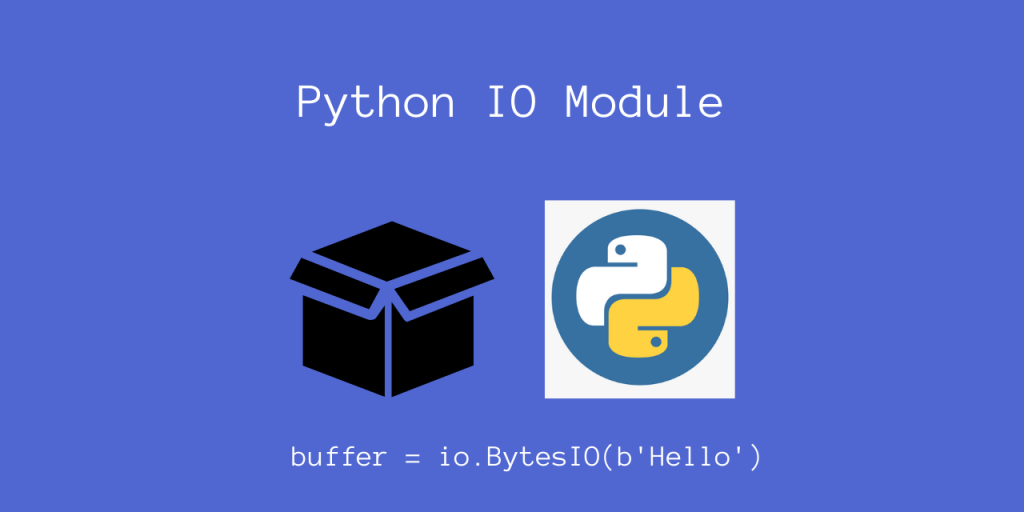文章内容如有错误或排版问题,请提交反馈,非常感谢!
io模块简介
io模块是Python标准库中的一个核心模块,提供了Python对I/O操作的基本支持。它支持各种文件和流的读写操作,并且为不同类型的I/O操作提供了统一的接口。io模块是Python3引入的,用于替代Python2中的file对象和一些旧的I/O相关模块。

主要功能
- 文件和流的读写:提供了文件操作的基本功能。
- 内存缓冲:支持在内存中进行文件操作。
- 文本和二进制流:支持处理文本流和二进制流。
- 自定义I/O:支持自定义实现输入输出流。
使用场景
- 文件操作:io模块用于处理文件和流的读写操作。
- 内存操作:使用BytesIO和StringIO在内存中处理数据,适用于测试和处理临时数据。
- 自定义流:通过继承IOBase类,可以实现自定义的I/O行为和数据流处理。
io模块的使用
核心类
- IOBase: 这是所有流对象的抽象基类。它不提供具体实现,但定义了一些基础接口。
- RawIOBase: 继承自IOBase,用于处理原始二进制流。直接处理字节,不进行任何编码或解码。
- BufferedIOBase: 继承自IOBase,用于缓冲二进制流。这类流支持更高效的读写操作。
- TextIOBase: 继承自IOBase,用于文本流。它处理字符串,并支持编码和解码。
io.IOBase:io模块中所有流的基类,定义了常用的I/O操作接口。
方法:
- read(size=-1):读取数据。
- write(data):写入数据。
- flush():刷新缓冲区。
- seek(offset, whence):设置当前位置。
- tell():返回当前位置。
import io
class CustomIO(io.IOBase):
def __init__(self, initial_data):
self.data = initial_data
self.position = 0
def read(self, size=-1):
if size == -1:
size = len(self.data) - self.position
result = self.data[self.position:self.position+size]
self.position += size
return result
def write(self, data):
self.data += data
def seek(self, offset, whence=0):
if whence == 0:
self.position = offset
elif whence == 1:
self.position += offset
elif whence == 2:
self.position = len(self.data) + offset
custom_io = CustomIO('Hello, World!')
print(custom_io.read(5)) # 输出'Hello'
custom_io.write('Python!')
custom_io.seek(0)
print(custom_io.read()) # 输出'Hello, World!Python!'
具体实现类
- FileIO: 继承自RawIOBase,用于读取和写入文件的原始字节流。
- BytesIO: 继承自BufferedIOBase,用于在内存中读写二进制数据。适合于需要在内存中处理二进制数据的场景。
- BufferedReader: 继承自BufferedIOBase,用于缓冲读取二进制数据。
- BufferedWriter: 继承自BufferedIOBase,用于缓冲写入二进制数据。
- BufferedRandom: 继承自BufferedIOBase,支持可读可写的缓冲二进制流。
- StringIO: 继承自TextIOBase,用于在内存中读写文本数据。适合于需要在内存中处理字符串的场景。
- TextIOWrapper: 继承自TextIOBase,用于对缓冲二进制流进行编码和解码,通常用于将 BufferedIOBase 的实例转换为文本流。
io.StringIO:在内存中读写文本数据的流。
方法:
- read(size=-1):读取缓冲区内容。
- write(string):写入字符串数据。
- seek(offset, whence):设置当前位置。
- tell():返回当前位置。
import io
# 创建一个StringIO对象
s = io.StringIO()
# 写入文本
s.write('Hello,')
s.write('World!\n')
# 获取当前内容
content = s.getvalue()
print(content) # 输出: Hello,World!
# 读取内容
s.seek(0) # 移动到文件开头
print(s.read()) # 输出: Hello,World!
# 关闭对象
s.close()
io.BytesIO:在内存中读写二进制数据的流。
方法:
- read(size=-1):读取缓冲区内容。
- write(b):写入字节数据。
- seek(offset, whence):设置当前位置。
- tell():返回当前位置。
import io # 创建一个BytesIO对象 b = io.BytesIO() # 写入二进制数据 b.write(b'Hello,') b.write(b'World!\n') # 获取当前内容 content = b.getvalue() print(content) # 输出: b'Hello,World!' # 读取内容 b.seek(0) # 移动到文件开头 print(b.read()) # 输出: b'Hello,World!' # 关闭对象 b.close()
io.TextIOWrapper:提供对文本文件的读取和写入。
方法:
- read(size=-1):读取文件内容,size参数指定要读取的字节数。
- write(string):将字符串写入文件。
- flush():刷新文件的内部缓冲区。
- seek(offset, whence):设置文件当前的位置。
- tell():返回文件当前的位置。
import io
# 打开一个二进制文件
with open('binary_file.bin', 'rb') as binary_file:
# 将二进制流包装为文本流
text_file = io.TextIOWrapper(binary_file, encoding='utf-8')
# 读取文本内容
content = text_file.read()
print(content)
# 关闭文本流
text_file.detach() # 断开与二进制流的连接
io.BufferedReader和io.BufferedWriter提供对二进制文件的缓冲读写操作。
方法:
- read(size=-1):读取指定字节数的数据。
- write(b):写入字节数据。
- flush():刷新缓冲区。
import io
# 打开一个文件进行读取
with open('large_file.bin', 'rb') as raw_file:
buffered_reader = io.BufferedReader(raw_file)
# 读取数据
chunk = buffered_reader.read(1024)
while chunk:
print(chunk)
chunk = buffered_reader.read(1024)
# 打开一个文件进行写入
with open('output_file.bin', 'wb') as raw_file:
buffered_writer = io.BufferedWriter(raw_file)
# 写入数据
data = b'This is some binary data.'
buffered_writer.write(data)
buffered_writer.flush() # 确保数据写入文件
io.FileIO
FileIO类用于处理原始的二进制文件操作。
import io
# 打开一个文件进行读取
with io.FileIO('example.txt', 'r') as file:
content = file.read()
print(content.decode('utf-8')) # 解码为文本
# 打开一个文件进行写入
with io.FileIO('example.txt', 'w') as file:
file.write('Hello, World!'.encode('utf-8'))
常用函数
io.open(file, mode=’r’, buffering=-1, encoding=None, errors=None, newline=None, closefd=True, opener=None):
- file:要打开的文件名。
- mode:打开文件的模式,如’r’(读取)、’w’(写入)、’b’(二进制)等。
- buffering:缓冲策略,默认为-1(自动选择缓冲策略)。
- encoding:文本编码,默认为None(使用系统默认编码)。
- errors:指定错误处理方案,如’ignore’或’replace’。
- newline:控制如何处理换行符,默认为None。
用于打开文件并返回相应的文件对象。open 是 io 模块中最常用的函数之一,允许指定文件的打开模式(如读、写、追加等)和编码方式。
示例:
import io
# 打开文件进行读取
with io.open('file.txt', 'r', encoding='utf-8') as f:
content = f.read()
print(content)
注意事项
- 模式:在打开文件时,确保选择正确的模式(文本模式还是二进制模式)。
- 编码:处理文本数据时,确保使用正确的编码,避免数据损坏。
- 资源管理:使用with语句确保文件和流被正确关闭,避免资源泄漏。



